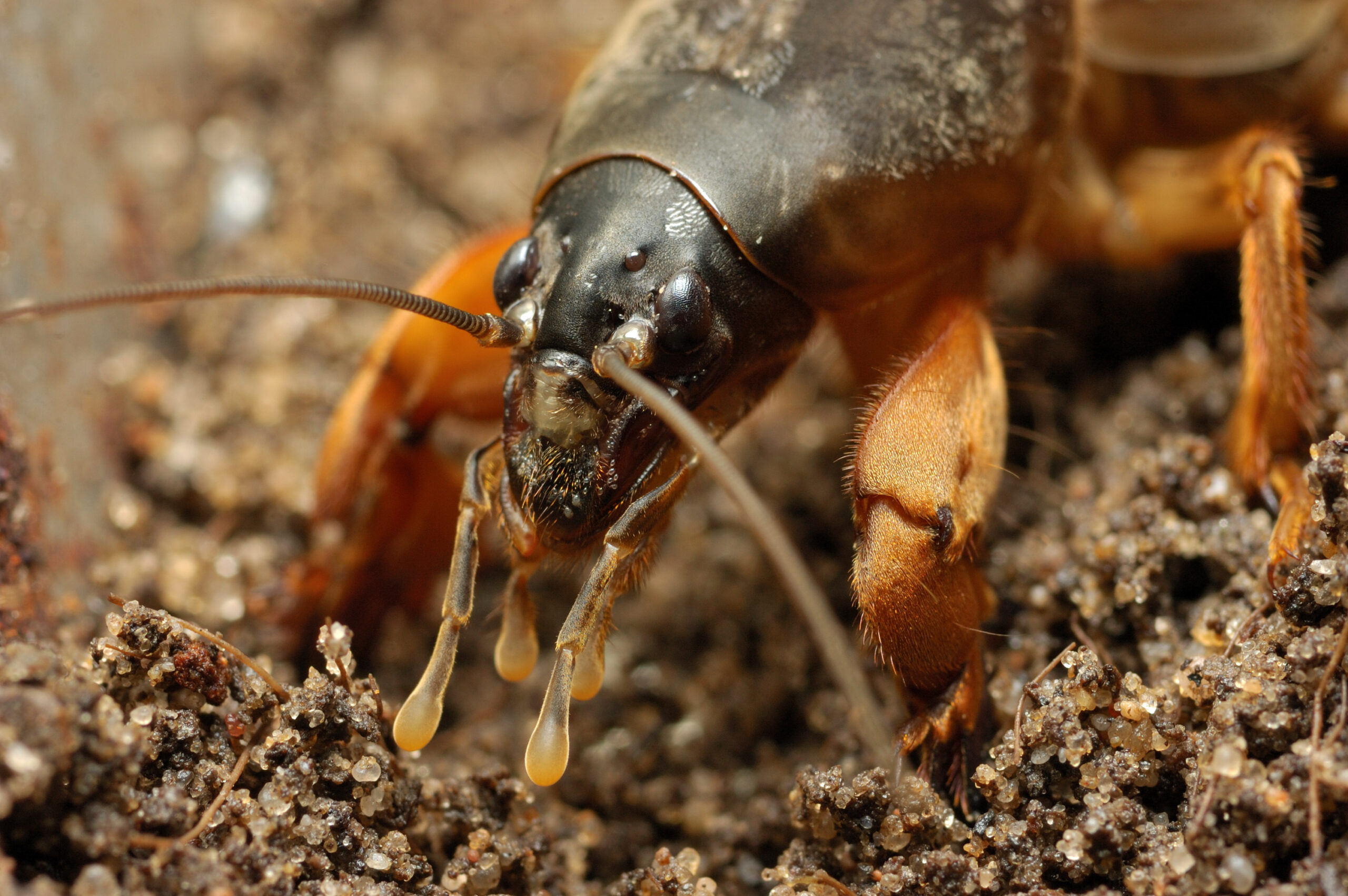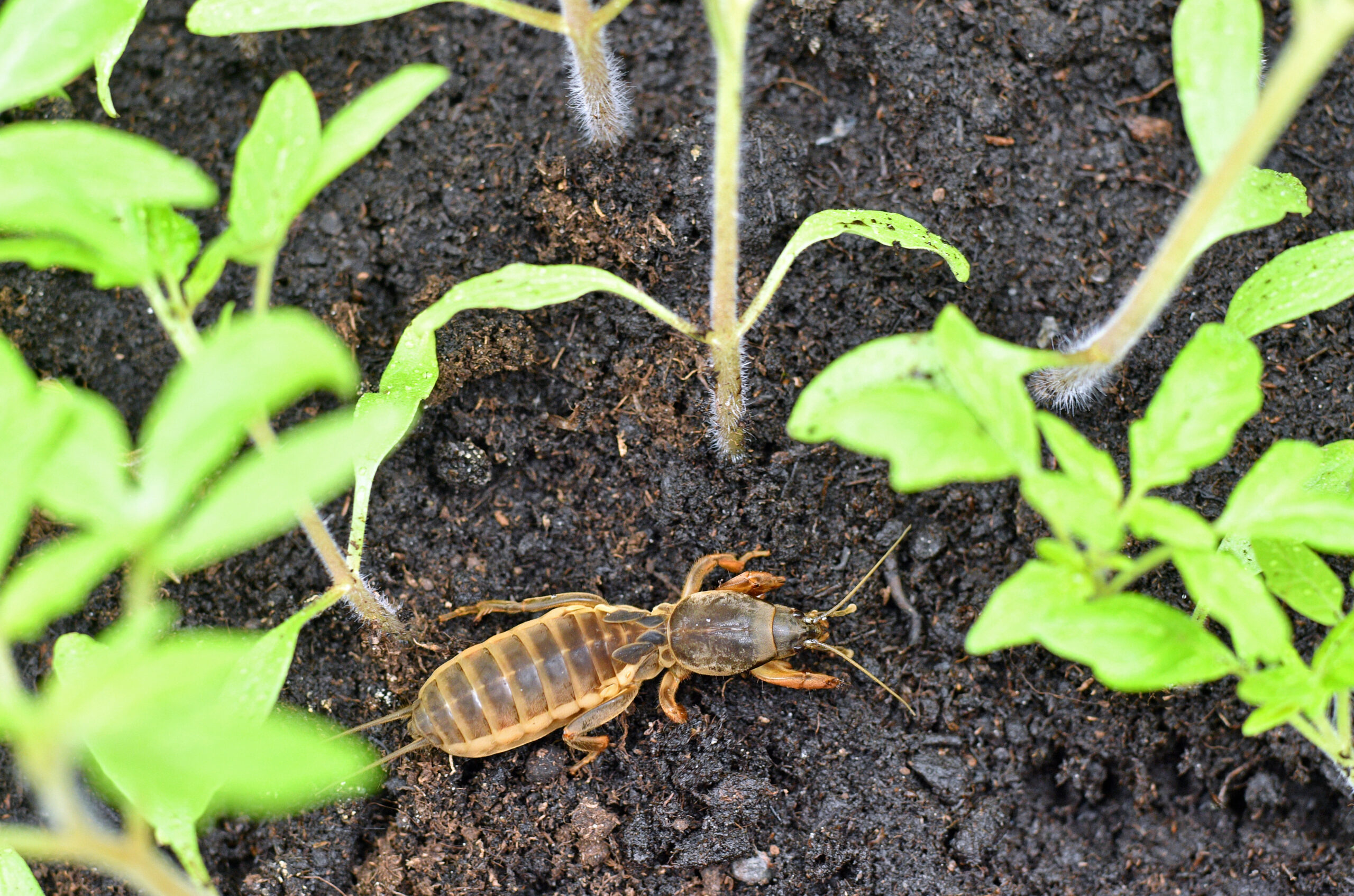Maddening Mole Crickets
Maddening Mole Crickets
As opposed to other pests, crickets are not primarily known for a distinctive diet or nest. Rather, the main trait that crickets are known for is their chirping that has been the background music of summer evenings for generations. While it is true that most cricket species chirp as a method of finding mates, one cricket is well-known for a different kind of ability. The mole cricket is accurately named, as it functions much like that furry critter that likes to make a mess of our lawns. This brings up several questions, like why a cricket would need to dig deeper into the ground and how they differ from other cricket species that are much more famous. Let’s dive into the underground world of mole crickets and why they prefer digging into the earth over staying above ground to enjoy the typical cricket activities.
The Life Cycle

In general, the life cycle of mole crickets is the same as other crickets, save for the locations of their homes. They are nocturnal and can be active year-round, but are the most prevalent in spring and fall when the eggs hatch. Each mole cricket species usually generates one new generation per year, with the primary egg-laying time being in April and May. Although male mole crickets do chirp to find their mates, they need to first scope out a safe location for the female to lay eggs. The male will dig a tunnel in the topsoil, carving a hole in the very top, and chirp from there until a female hears him and flies in the tunnel to mate. The female will then carve 3 to 5 chambers that branch off from the original tunnel and lay egg clusters over the span of multiple days. The initial egg cluster will have anywhere from 2 to 40 eggs, and the female will lay up to 150 eggs in her lifetime. The hatchlings are sadly left to fend for themselves, as the males die after mating and females pass after laying all the eggs.
On average, the eggs will hatch 20 days later. But this number is dependent on the temperature of the soil, as they will hatch sooner (and the adults will be more active) when it’s warm. For the eggs laid in spring, the larvae will molt 6 to 8 times throughout the summer before entering the adult stage. Mole crickets can overwinter as larvae or adults, so the eggs that are laid in autumn will likely hatch during the last warm days of the season. As adults, mole crickets are tan or dark brown in color. Their length depends on the species. In reference to the two most common species, tawny mole crickets are 1.5 to 2 inches long, and southern mole crickets are 1 to 1.5 inches long. Mole crickets live about 2 to 3 years total, depending on their environment, and their most destructive phase is definitely (and unfortunately) their adult stage.
The Habitat and Diet

True to their name, mole crickets spend most of their time underground. They will stay in their burrows during the day, and emerge to eat and explore at night. These crickets have been in the U.S. for over a century, as they are believed to have hitched a ride on ships from South America in the early twentieth century. Today, they are the most common in the southeastern states. Since many mole crickets like turf grass for their homes and food, they are frequent problem pests for golf courses, pastures, and lawns. The adults feed more when the soil is warm and wet, so grass that is frequently watered throughout the summer is the most susceptible to an invasion.
Although the larvae don’t cause nearly as much damage as adults, any stage of mole crickets will be a major problem at some point. Many mole cricket species eat from the greenery that they live underneath, especially if that greenery is healthy and damp. For instance, tawny mole crickets eat the roots and shoots of grass, which means they do not have to stay on the surface to find their food. While most mole crickets share this diet, there are some that would rather eat the other pests that are also invading the topsoil. The southern mole cricket will eat organisms in the shallow parts of the soil, which is technically beneficial but can still be destructive if the mole crickets tear up the roots in the process of finding food. It can be a strange experience to learn that a bunch of small crickets are the culprits behind the holes and trails in your lawn, but these pests are well-equipped to carve through any soil they stumble across in their search for the best home.
The Gift of the Mole Cricket

It just takes one look at a mole cricket to see how they can carve through roots and soil with ease. Their front legs have four claws that they use for tunneling, and these appendages look very similar to the large “hands” of moles. Mole crickets can tunnel 10 to 20 feet, but they like to stay close to the surface. They will cut through grass roots and push the dirt up as they go, which makes it easy to see the direction of their tunnels. Since these crickets can fly great distances, it is nearly impossible to find where they came from before they found an optimal tunneling area in this lawn. The small chamber that the male cricket digs to begin his family’s home has a shape unique to mole crickets. It’s essentially funnel-shaped and forms a dirt mound on the surface of the grass. There is a hole in the middle of the dirt that will act as the megaphone for the male cricket’s calls.
Although they are much smaller than actual moles, mole crickets can cause some extensive damage to the grass they tunnel through. This tunneling is worse for turf grass, as it is more delicate than other grasses. As stated earlier, mole crickets like to stay as close to the surface as possible, but there are two main instances where they will dig a little deeper. The first is when the weather is too hot for their taste, in which case they will tunnel deeper to keep cool. The other is every October, where the adult mole crickets will carve tunnels much deeper into the soil in order to overwinter in a protected state. The primary way to spot a mole cricket invasion is to keep an eye on the grass. When mole crickets have been tunneling under grass, the lawn will start to feel spongy and dry out in the most effected spots. This is due to the crickets detaching the roots from the grass, which is the primary issue with this pest.
The Common Issues

When it comes to mole crickets, the main concern is not any kind of danger to humans or pets. These insects don’t have any interest in invading our homes or getting anywhere near creatures larger than them, and they do not carry diseases. But for anyone who cares about their lawn, mole crickets are a definite concern. The caretakers of golf courses and sports fields need to keep an extra close watch on their grass, as it is crucial that these grasses are as smooth as possible. There are two primary consequences of a mole cricket invasion, both of which make it difficult for grass to bounce back. One is that the crickets can make the grass ugly by causing brown patches and excessive weed growth through the severing of roots. If the invasion is not addressed, it can kill the grass entirely. The other result of an extensive infestation is that mole crickets have their own predators that will not hesitate to dig up the grass in search of their food. Birds and raccoons commonly enjoy crickets of all kinds, and they will pluck mole crickets from their chambers, simultaneously making a mess of the grass.
Since mole crickets are nocturnal and spend so much time underground, it’s difficult to tell if any lawn issues are because of these specific pests. Multiple sources say that the best way to test for mole crickets is to directly address the areas of concerns. By mixing dish soap and water and pouring it onto the patchy areas, any underground mole crickets will evacuate a few minutes later, thus giving away their position. It is best to implement control methods in the late spring and early summer, as this is when the eggs are hatched and no longer protected. Mole crickets are most vulnerable in the larval stage because they are closest to the surface. Many reputable lawn care companies have specific treatments for pests such as these, as well as multiple pest control companies. The simplest way to prevent mole crickets from becoming a problem in the first place is to take care of the grass. Keep the soil healthy and fertilized, mow the lawn often, and be careful not to overwater any time of year. A healthy lawn is a happy lawn, and a happy lawn is far less likely to experience a mole cricket infestation!
Green Pest Services Digs Deeper into Pest Problems
Spring is a time for enjoying the warm weather and the new growth on all of the beautiful plants, flowers, and trees in your yard. Unfortunately, spring is also the primary time for pest eggs hatching and the expansion of eusocial insects’ colonies. When the temperature is warmer, insects and arachnids are more active since cold-blooded creatures rely on warmth for high energy levels. Whether mole crickets are munching on the roots or a slew of garden insects are chewing holes in leaves and produce, the greenery outside is constantly at risk of being invaded by pests! At Green Pest Services, we leave no stone unturned when it comes to searching for pest problems. Our team of knowledgable technicians will formulate a custom treatment plan for each pest issue, with the goal of eliminating the pests as efficiently and thoroughly as possible. Contact us for more information on our eco-friendly services and why you can be sure that your plants will stay clean when you go Green!
Citations
Forrester, G. & Williamson, J. (Dr.). (2022, August 24). Mole cricket management in turfgrass. Clemson Cooperative Extension: Home & Garden Information Center. Available at https://hgic.clemson.edu/factsheet/mole-cricket-management-in-turfgrass/ (Accessed on March 14, 2023).
How to kill mole crickets in the lawn. (n.d.). Ortho. Retrieved March 14, 2023, from https://ortho.com/en-us/insect-control/how-to-kill-mole-crickets-in-the-lawn.html
Mole crickets. (n.d.). University of Florida IFAS Extension. Retrieved March 14, 2023, from https://sfyl.ifas.ufl.edu/lawn-and-garden/mole-crickets/

